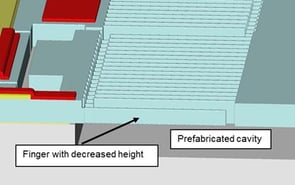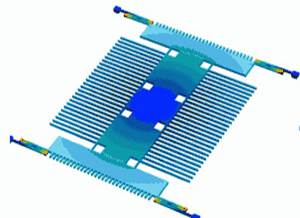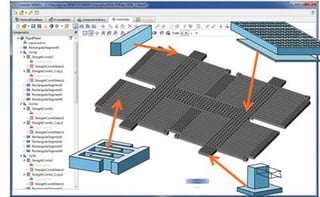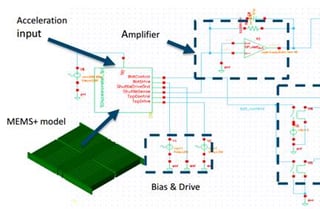MEMS Design Contest
|
Prize Awards Announced! May 9, 2018 We received a large number of excellent design submissions from all over the world, and want to thank all of the contestants for their participation. Contest organizers carefully evaluated all submissions, and have selected the 1st, 2nd and 3rd place prize winners. Finalist selection criteria included technical innovation and excellence, novelty, adherence to the design flow, organizational strength, quality of documentation, and educational value. Congratulations to our 1st, 2nd and 3rd Place Prize Winners:
Congratulations to all the finalists again on your hard work! |
Finalist Video
The winning teams from ESIEE Paris / Sorbonne Université (combined team) and KAUST discuss their prize-winning entries for the MEMS Design Contest. They discuss how they learned about the contest, and talk about their team, their design idea, the challenges that they faced, and lessons from the experience.
Contestant Interview
In this video, Sally Ahmed of KAUST talks about her participation in the ongoing MEMS Design Contest. Sally explains how she became interested in the contest, describes her contest design, and discusses what she has learned through her participation in the contest.
Introduction
The Cadence Academic Network, X-FAB, Coventor, and Reutlingen University have teamed up to organize a worldwide MEMS Design Contest. Let’s see who can design and build the best MEMS and mixed-signal designs
—show us your ideas and win exciting prizes! If you don’t know how to use those tools, don’t worry! We’ll provide several workshops to familiarize you with the design tools and technologies.
Click on the following to learn more about the design contest details:
Design Challenge
Contestants can choose to design one or more of the following items:
1. Design an innovative MEMS device, leveraging Cadence and Coventor design tools and a proven X-FAB MEMS Manufacturing Process (XMS10 or XMB10).
The X-FAB XMB10 MEMS manufacturing process will support MEMS designs such as MEMS-based inertial sensors, including gyroscopes and acceleration sensors, along with other types of products. As an example, you could design a TPMS (tire pressure monitoring system) using a pressure sensor, acceleration sensors, temperature sensors plus CMOS logic
Supported features of the X-FAB XMB10 process include:
- Sensor wafers with prefabricated, hidden cavities, proven for inertial sensors (accelerometers and gyroscopes)
- Movable structures created from monocrystalline silicon
- Capacitive actuation and sensing
- Comb fingers with decreased height for out-of-plane actuation
- Wafer level bonding for hermetic sealing



2. Design a mixed-signal MEMS driver and read-out logic ASIC using the Cadence Design platform and the X-FAB XH035 or XH018 high voltage CMOS process.
3. Design a co-designed MEMS and CMOS product, using Coventor MEMS+ and Cadence design tools


MEMS design in Coventor MEMS+ environment using XMB10 PDK Co-simulation of MEMS+ model and driver IC in Cadence Virtuoso
|
1st Prize: |
|
|
2nd Prize: |
|
|
3rd Prize: |
|
|
On line registration and proposal submission - July 17, 2016 - December 31, 2016 |
|
• Candidates submit (on the public contest website) a proposal with a description of their project • Proposal is reviewed by sponsors to assess suitability for manufacturing with the X-FAB processes • Potential contestants are notified regarding acceptance/rejection of their proposal. Modified proposals can be submitted until the proposal deadline, if a original proposal is not accepted. • Accepted contestants must sign an NDA with X-FAB to obtain documentation on the X-FAB PDKs |
|
Deadline for detailed proposal submission - December 31, 2016 |
|
• Review of proposal submissions by sponsors between December 31, 2016 - February 28, 2017 |
|
Acceptance notification - February 28, 2017 |
|
• Accepted teams are expected to have access to Cadence tools and are provided with Coventor MEMS design software for the duration of the contest (until December 31, 2017) at no cost • Contestant teams start detailed design work • Coventor, Cadence and X-FAB will provide online workshops and design reviews for all teams |
|
Final design submission deadline - January 21, 2018 |
|
• Designs are reviewed by a jury selected by the sponsors. |
|
Announcement of Finalists - March 15, 2018 |
|
CDNLive EMEA2018 Award Ceremony - May 7-9, 2018 |
Detailed Design Requirements
- The solution can include two designs:
- MEMS device in X-FAB XMS10 or XMB10 technology
- Mixed-signal MEMS-driver and read-out logic ASIC in X-FAB XH035 or XH018 HV CMOS technology
-
Teams may design both a MEMS and CMOS device, design a CMOS device only (using an available MEMS device template from X-FAB), or design and package a MEMS device only. All of these alternatives are acceptable contest submissions.
-
Two design groups (one for MEMS, one for logic) can apply as a single contestant.
-
Contestants should leverage the use of both the Coventor and Cadence PDKs, as well as the Coventor and Cadence design environments.
-
Teams should create a proposal, implement a schematic, simulate the design, produce a design layout of the solution, co-simulate both designs to show their functionality, and present the simulation waveforms and the layout at the end of the project.
We will provide a presentation template that can be used to present the results of your design
Application Procedure
Applications are no longer being accepted for the MEMS Design Contest
Online Registration and Proposal Submission:
-
Potential contestants should register on-line and provide a proposal of their project.
Proposal Review:
-
Organizers will review the feasibility and scope of the team's proposal, and determine if the team's project can be successfully completed using the XFAB PDK and Coventor/Cadence design tools.
-
Proposals will be reviewed by the organizers. Design groups with acceptable proposals will receive a Non-Disclosure Agreement (NDA) from X-FAB.
-
Once the NDA is signed, the contestants will obtain access to the XMB10 and XMS10 process design kit (PDK) documentation.
The deadline for the Proposal Submission is December 31, 2016.
Design Phase:
- Design groups who pass the proposal stage will be invited to participate in the contest, and will be provided with access to the full XFAB PDKs and Coventor's MEMS design software at no charge for the duration of the contest. Contestants can obtain Cadence software through normal distribution channels, or contact Cadence directly if they do not currently have a Cadence software license.
- In order to familiarize design groups with MEMS/mixed-signal co-design, workshops and support will be provided to the contestants by the organizers.
After the design phase, the jury will select the winning teams.
Evaluation Criteria
The solution will be judged by a jury from industry and academia and based on the following criteria:
-
Degree of innovation in the proposed MEMS/ASIC hardware
-
Degree of innovation in the proposed MEMS/ASIC design methodology
-
Novelty of the application of the proposed MEMS/ASIC design
-
Educational value
-
Demonstration/PR value
-
Organizational value
Stay Updated
Related Information
|
|
|
|
|
|
![]()
